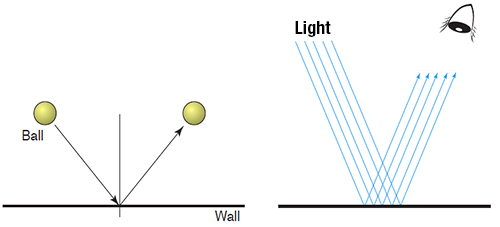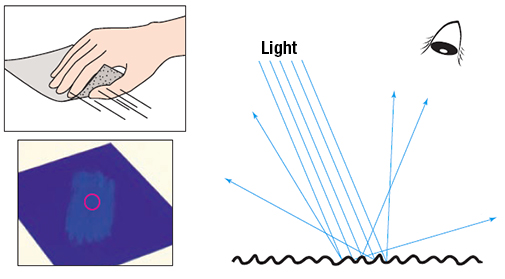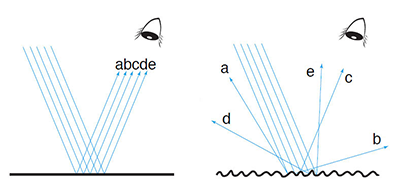Specular Component Included (SCI) vs. Specular Component Excluded (SCE)
How Surface Conditions May Affect the Color and Appearance of Your Samples
The texture and glossiness of your samples may make them appear brighter, duller, lighter, or darker. This is because an object’s surface condition directly affects how the wavelengths of light reflect off that object and how our eyes will perceive its appearance. To more effectively evaluate and control the color and appearance of your samples and meet standards, it should be understood how light interacts with various surface conditions and how that interaction affects the appearance of color.
The Influence of Surface Conditions on Color
Color is perceived when light reflects off of an object and stimulates the cones in our eyes. Every moment we are awake and wide eyed, these cones are sending messages to our brain to translate what color we are seeing in front of us. There are two ways light reflects off of an object, referred to as specular reflection and diffuse reflection, each affecting how the human eye perceives an object’s color.
Specular Reflection: When a ball is bounced on a wall, it may bounce off at the same angle in the other direction. With specular reflection, light reflects in the same way – at an equal, but opposite, angle (see Figure 1). This reflection of light occurs more strongly on shiny and glossy surfaces, making an object appear more saturated and vivid in color.

Figure 1
When light hits an object, however, not all of it reflects at this specular angle. The rest of the light is absorbed by the object or scattered in various directions.
Diffuse Reflection: The diffuse reflection of light refers to when light is scattered in various directions (see Figure 2). This reflection of light occurs more strongly on rough, textured, and irregular surface conditions, making an object appear less saturated and duller in color.

Figure 2
The appearance of an object’s color greatly depends on its surface conditions, the angles at which light is reflected from the object to our eyes, and how strongly light is reflected from these angles. An object with a glossy surface will appear more saturated to the human eye than the same object with a matte surface because the specular reflection of light is much stronger than the diffuse reflection of light. When formulating or evaluating the color of a sample, it is important to remember:
- High gloss surfaces cause a strong specular reflection of light and weak diffuse reflection of light, resulting in a more saturated, vivid color
- Semi-gloss surfaces cause the specular reflection of light to mix with the diffuse reflection of light, resulting in a less saturated, lighter color
- Matte surfaces cause a strong diffuse reflection of light and weak specular reflection of light, resulting in a less saturated, duller color
Color Measurement: Specular Component Included or Specular Component Excluded?
A glossy object dyed a blue color will appear more saturated and vivid, while a rough-surfaced object dyed the exact same blue color will appear duller. Although the dye color is the same on both objects, their appearance still differs. Certain color measurement instruments, including spectrophotometers, can quantify the “true” color of the object or the appearance of the object to help users control its color and appearance. This is done through the instrument’s measurement modes, Specular Component Included (SCI) and Specular Component Excluded (SCE).
To measure the “true” color of an object, SCI mode is typically used. This type of measurement includes both specular and diffused reflected light, making it unaffected by any surface conditions. If we measure the two blue objects mentioned above, a measurement in SCI mode would generate the same color values for both objects. This mode is ideal when formulating recipes to match colors and meet color quality standards more effectively.
To measure the appearance of an object’s color, SCE mode is typically used. This type of measurement excludes any specular reflected light, making it more sensitive to surface conditions. If we measure the two blue objects mentioned above, a measurement in SCE mode would generate different color values for each object. The glossy object would fall in a darker, more saturated region of the defined color space and the rough-surfaced object would fall in a lighter, less saturated region of the defined color space. This mode is more often used during quality control evaluations to ensure the appearance of their products maintain consistency and meet the standard.
Like this article? Click here to sign up for our monthly Color Trends & Technology newsletter to stay updated on the element of color, best practices for controlling and evaluating the color of objects, educational seminars, and advanced technology for research and manufacturing environments.
The technological leader in color and light measurement solutions, Konica Minolta Sensing Americas helps organizations formulate, evaluate, and control color to meet product quality and operational goals more efficiently.











